Women working in the fish industry, 1994
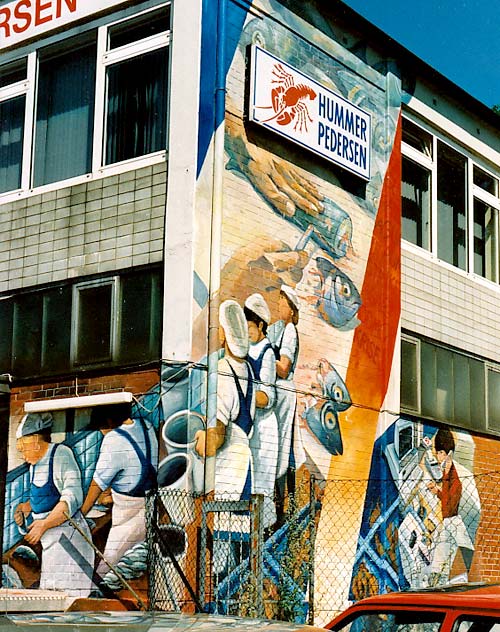
"Women working in the fish industry"
East and south wall Große Elbstraße 152
Design and realisation: Cecilia Herrero, Janet Pavone, Hildegund Schuster.
Sponsors: R&S Baugesellschaft - Photo: Hildegund Schuster ©
In 2014, the mural vanished without replacement during the modernisation work to the Hummer Pedersen building.
In 2015, a new mural was painted with a focus on: fish industry 2015
The first picture of the Women's Open Air Gallery Hamburg highlights fish processing as one of the main activities performed in this area. Here we find ourselves at the eastern end of Hamburg's Altona Fish Market. The mural on the building belonging to Hummer Pedersen (east and south wall) reveals what goes on behind these and other walls: women at work filleting fish and in the office.
The mural is an artistic cooperation between the three painters Cecilia Herrero from Argentina, Janet Pavone from New York and Hildegund Schuster from Hamburg.
Working with fish is a job that has always mainly been done by women. The work is poorly paid and a burden to their health (standing all day in cold, wet, draughty conditions, often as piecework). Women were and sometimes still are said to be nimble, patient, suitable for so-called household-related tasks and jobs that were categorised as being physically "light". Such low-wage categories for industrial women's work existed in West Germany until 1975. The wages paid to women in these categories were approx. 30-40% less than what men received.
For a long time, working in the fish branch was said to be objectionable in more ways than one: the workers always smelt of fish, and were stigmatised by their poor-woman's job. Right up until the period after the second war, it was said that no-one worked in the fish industry if they didn't have to.

The artists Cecilia Herrero (on the left) and Janet Pavone.
Photo: Hildegund Schuster ©
During the period of full employment triggered by the economic miracle, labour was in short supply particularly in this sector. Hamburg started to systematically recruit migrant workers in 1961. Migrants from Turkey and other Mediterranean countries performed the jobs that "Germans no longer wanted to do", to quote a shop steward from Hamburg.(1)
In the mural, the women at work filleting fish are separated from the office workers by the word strips. As in all the Women's Open Air Gallery pictures, they reflect and extend the topic of the picture with words in several languages. Here: hladnoca - cold (Yugoslavian), recruit, nappies, odmor - holiday (Croatian), agape - love (Greek), colleague, dream, money.
The woman's hand filleting a fish at the top of the mural appears like a vision. It clearly shows what the women have to do at the worktables, while at the same time recalling the predecessor mural from 1989, which also depicted women working in the fish industry.
© Elisabeth von Dücker, 2011
(1) Elisabeth von Dücker: "We stank of vinegar all the time, but so what, we had to earn money somehow". Working conditions for women in Hamburg's fish industry, in: "not just figureheads. Women talk about working in the port of Hamburg”, published by the Women’s Working Party and the Museum of Work (ergebnisse Verlag - publisher), Hamburg, 1989, p. 101.
Picture gallery
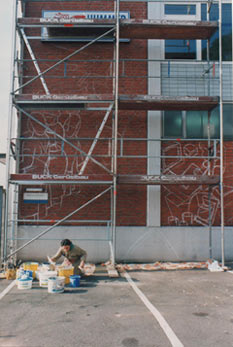
Outlines on the wall.
Photo: Hildegund Schuster ©
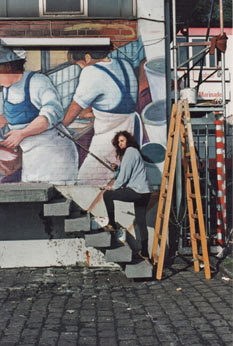
Janet Pavone paints the last corner.
Photo: Hildegund Schuster ©

Looking over the artist's shoulder.
Photo: Hildegund Schuster ©
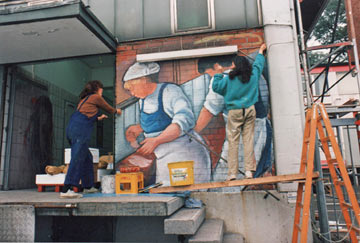
Defining a line.
Photo: Hildegund Schuster ©
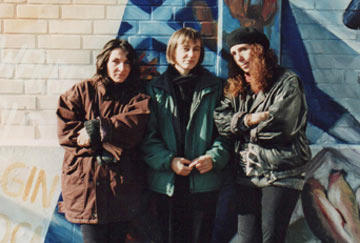
The artists Cecilia Herrero (on the left, Hildegund Schuster (in the middle),
Janet Pavone.
Photo: Hildegund Schuster ©
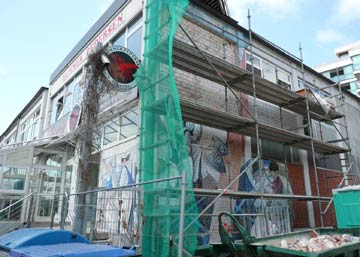
Demolition of the old fish mural at Hummer Pedersen. 2013.
Photo: Elisabeth von Dücker ©

